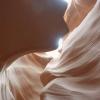Ho trovato questo articolo in cui si parla dello sviluppo e della produzione del sensore LBCAST dlle D2h.
Sviluppato da Nikon ma prodotto in outsourcing pur con il controllo di qualit? Nikon :
According to an article in the Japanese Nikkei, Nikon has developed a new image sensor based on a new 'LBCAST' technology (which appears to be similar to CMOS but faster). This new sensor design allows data to be read twice as fast as standard sensors. The new sensor is destined for digital SLR's, to quote the article "An SLR camera with the LBCAST sensor will be capable of consecutive shooting at the best level for CMOS cameras made by other companies, or 8 shots per second, which is also more than twice that of ordinary compact digital cameras with CCD (charge-coupled device) sensors." As far as I know this is the first in-house developed sensor from Nikon.
Nikon Develops Faster Image Sensor For Digital Cameras
TOKYO (Nikkei)--Nikon Corp. (7731) has developed new technology for image sensors used in digital cameras that enables them to read data about twice as fast as current standard models, The Nihon Keizai Shimbun learned Thursday.
Nikon will begin volume production of the new sensors -- which serve as electronic eyes in digital cameras -- as early as this month. They will be installed in digital SLR (single-lens reflex) cameras slated for release in the fall.
The new LBCAST (lateral buried charge accumulator and sensing transistor array) sensor will use the same power-saving semiconductor elements as those in CMOS (complementary metal-oxide semiconductor) sensors. But because the circuitry structure of LBCAST pixel elements is simpler than that used in CMOS sensors, Nikon succeeded in miniaturizing the sensor and improving its performance.
Because the sensors are able to read image data at a higher speed, they enable high-speed photography and higher-resolution imaging. An SLR camera with the LBCAST sensor will be capable of consecutive shooting at the best level for CMOS cameras made by other companies, or 8 shots per second, which is also more than twice that of ordinary compact digital cameras with CCD (charge-coupled device) sensors.
By increasing the surface area of the sensor's photodiodes, the sensor elements that receive light, Nikon was able to improve the contrast and color gradations of images. The company is expected to offer new cameras equipped with LBCAST sensors that have a resolution of roughly 4 megapixels.
Nikon will outsource production of LBCAST wafers, but will handle the final production stages of items like microlenses and filters itself.
Nikon has a high share of the global digital SLR market, but ranked fifth in the overall digital camera market in 2002. Until now, it has relied on other companies, such as Sony Corp. (6758), to supply image sensors. But as digital cameras become the global norm for both general consumers and professionals, the firm determined that developing in-house technology was important for such higher-end products such as SLRs. The company will continue to use sensors produced by other manufacturers for its consumer-grade compact digital cameras.
(The Nihon Keizai Shimbun Friday morning edition)




 Kaiserliche Marine
Kaiserliche Marine 
 Isle of Man
Isle of Man 












